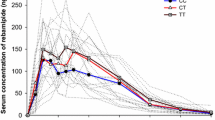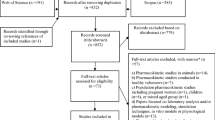Abstract
Objectives
Digoxin is a well-known probe for the activity of P-glycoprotein. The objective of this work was to apply different methods for covariate selection in non-linear mixed-effect models to study the relationship between the pharmacokinetic parameters of digoxin and the genotype for two major exons located on the multi-drug-resistance 1 (MDR1) gene coding for P-glycoprotein.
Methods
Thirty-two healthy volunteers were recruited in three pharmacokinetic drug interaction studies. The data after a single oral administration of digoxin alone were pooled. All subjects were genotyped for the MDR1 C3435T and G2677T/A genotypes. The concentration-time profile of digoxin was established using 12–16 blood samples taken between 15 min and 72 h after administration. We modelled the pharmacokinetics of digoxin using non-linear mixed-effect models. Parameter estimation was performed using the stochastic approximation EM method (SAEM). We used three methods to select the covariate model: selection from a full model using Wald tests, forward inclusion using the log-likelihood ratio test and model selection using the Bayesian Information Criterion.
Results
The three covariate inclusion methods led to the same final model. Carriers of two T alleles for the C3435T polymorphism in exon 26 of MDR1 had a lower apparent volume of distribution than carriers of a C allele. The only other covariate effect was a shorter absorption time-lag in women.
Conclusion
The apparent volume of distribution of digoxin is lower in TT subjects, probably reflecting differences in bioavailability. Non-linear mixed-effect models can be useful for detecting the influence of covariates on pharmacokinetic parameters.





Similar content being viewed by others
References
Anglicheau D, Verstuyft C, Laurent-Puig P, Becquemont L, Schlageter MH, Cassinat B et al (2003) Association of the Multidrug Resistance-1 gene single-nucleotide polymorphisms with the tacrolimus dose requirements in renal transplant recipients. J Am Soc Nephrol 14:1889–1896
Becquemont L, Verstuyft C, Kerb R, Brinkmann U, Lebot M, Jaillon P et al (2001) Effect of grapefruit juice on digoxin pharmacokinetics in humans. Clin Pharmacol Ther 70:311–316
Benjamini Y, Hochberg B (1995) Controlling the false discovery rate: a practical and powerful approach to multiple testing. J Roy Stat Soc B 57:289–300
Bonhomme-Faivre L, Devocelle A, Saliba F, Chatled S, Maccario J, Farinotti R et al (2004) MDR-1 C3435T polymorphism influences cyclosporine A dose requirement in liver-transplant recipients. Transplantation 78:21–25
Brendel K, Comets E, Laffont C, Laveille C, Mentré F (2006) Metrics for external model evaluation with an application to the population pharmacokinetics of gliclazide. Pharm Res 23:2036–2049
Cartron G, Dacheux L, Salles G, Solal-Celigny P, Bardos P, Colombat P et al (2002) Therapeutic activity of humanized anti-CD20 monoclonal antibody and polymorphism in IgG Fc receptor FcgammaRIIIa gene. Blood 99:754–758
Comets E, Mentré F (2001) Evaluation of tests based on individual versus population modelling to compare dissolution curves. J Biopharm Stat 11:107–123
Delyon B, Lavielle M, Moulines E (1999) Convergence of a stochastic approximation version of the EM algorithm. Ann Stat 27:94–128
Dempster A, Laird N, Rubin D (1977) Maximum likelihood from incomplete data via the EM algorithm. J Roy Stat Soc B 39:1–38
Diasio R, Johnson M (2000) The role of pharmacogenetics and pharmacogenomics in cancer chemotherapy with 5-fluorouracil. Pharmacology 61:199–203
Englund G, Hallberg P, Artursson P, Michaelsson K, Melhus H (2004) Association between the number of coadministered P-glycoprotein inhibitors and serum digoxin levels in patients on therapeutic drug monitoring. BMC Med 2:8
Ensom M, Chang T, Patel P (2001) Pharmacogenetics: the therapeutic drug monitoring of the future? Clin Pharmacokinet 40:783–802
Fabris M, Tolusso B, Di Poi E, Assaloni R, Sinigaglia L, Ferraccioli G (2002) Tumor necrosis factor-alpha receptor II polymorphism in patients from southern Europe with mild-moderate and severe rheumatoid arthritis. J Rheumatol 29:1847–1850
Girard P, Mentré F (2005) A comparison of estimation methods in nonlinear mixed effects models using a blind analysis. Population Approach Group in Europe Annual Meeting (Abstract 384). Available at: http://www.page-meeting.org./
Hornestam B, Jerling M, Karlsson MO, Held P (2003) Intravenously administered digoxin in patients with acute atrial fibrillation: a population pharmacokinetic/pharmacodynamic analysis based on the Digitalis in Acute Atrial Fibrillation trial. Eur J Clin Pharmacol 58:747–755
Johne A, Kopke K, Gerloff T, Mai I, Rietbrock S, Meisel C et al (2002) Modulation of steady-state kinetics of digoxin by haplotypes of the P-glycoprotein MDR1 gene. Clin Pharmacol Ther 72:584–594
Jonsson E, Karlsson M (1998) Automated covariate model building with NONMEM. Pharm Res 15:1463–1468
Kass R, Raftery A (1995) Bayes factors. J Am Stat Assoc 90:773–795
Kirchheiner J, Heesch C, Bauer S, Meisel C, Seringer A, Goldammer M et al (2004) Impact of the ultrarapid metabolizer genotype of cytochrome P450 2D6 on metoprolol pharmacokinetics and pharmacodynamics. Clin Pharmacol Ther 76:302–312
Kuhn E, Lavielle M (2005) Maximum likelihood estimation in nonlinear mixed effects models. Computer Stat Data Anal 49:1020–1038
Lavielle M, Mentré F (2007) Estimation of population pharmacokinetic parameters of saquinavir in HIV patients with the MONOLIX software. J Pharmacokinet Pharmacodyn (in press)
Ludden T, Beal S, Sheiner L (1994) Comparison of the Akaike Information Criterion, the Schwarz criterion and the F test as guides to model selection. J Pharmacokinet Biopharm 22:431–445
Maitre P, Buhrer M, Thomson D, Stanski D (1991) A three-step approach combining Bayesian regression and NONMEM population analysis: application to midazolam. J Pharmacokinet Biopharm 19:377–378
Mandema J, Verotta D, Sheiner L (1992) Building population pharmacokinetic-pharmacodynamic models. I. Models for covariate effects. J Pharmacokin Biopharm 20:511–528
McLeod H, Yu J (2003) Cancer pharmacogenomics: SNPs, chips, and the individual patient. Cancer Invest 21:630–640
Panhard X, Mentré F (2005) Evaluation by simulation of tests based on non-linear mixed-effects models in pharmacokinetic interaction and bioequivalence cross-over trials. Stat Med 10:1509–1524
Pinheiro J, Bates D (2000) Mixed-effects models in S and S-PLUS. Springer, New York
R Development Core Team (2004) R: a language and environment for statistical computing. R Foundation for Statistical Computing, Vienna, Austria
Raftery A (1996) Markov chain Monte Carlo in practice. Chapman & Hall, London
Ragueneau I, Poirier J, Radembino N, Sao A, Funck-Brentano C, Jaillon P (1999) Pharmacokinetic and pharmacodynamic drug interactions between digoxin and macrogol. Br J Clin Pharmacol 48:453–456
Robert C, Casella G (1999) Monte Carlo statistical methods. Springer, New York
Samson A, Lavielle M, Mentré F (2006) Extension of the SAEM algorithm to left-censored data in nonlinear mixed-effects model: application to HIV dynamics model. Computer Stat Data Anal 51:1562–1574
Samson A, Mentré F, Lavielle M (2005) Using SAEM, a new maximum likelihood estimation method in nolinear mixed-effects models, for comparison of longitudinal responses. In: 5th Int Meet Stat Methods in Biopharmacy. Paris, France
Sheiner L, Beal S (1998) NONMEM version 5.1. University of California, NONMEM Project Group, San Francisco
Simes R (1986) An improved Bonferroni procedure for multiple tests of significance. Biometrika 73:751–754
Spiegelhalter DJ, Thomas A, Best NG (2000) WinBUGS version 1.3 user manual. Imperial College, London, United Kingdom
Verstuyft C, Morin S, Yang J, Loriot MA, Barbu V, Kerb R et al (2003) A new, rapid and robust genotyping method for CYP2C9 and MDR1. Ann Biol Clin (Paris) 61:305–309
Verstuyft C, Schwab M, Schaeffeler E, Kerb R, Brinkmann U, Jaillon P et al (2003) Digoxin pharmacokinetics and MDR1 genetic polymorphisms. Eur J Clin Pharmacol 58:809–812
Verstuyft C, Strabach S, El Morabet H, Kerb R, Brinkmann U, Dubert L et al (2003) Dipyridamole enhances digoxin bioavailability via P-glycoprotein inhibition. Clin Pharmacol Ther 73:51–60
Wählby U, Bouw M, Niclas Jonsson E, Karlsson M (2002) Assessment of type I error rates for the statistical sub-model in NONMEM. J Pharmacokinet Pharmacodyn 29:251–269
Wählby U, Niclas Jonsson E, Karlsson M (2002) Comparison of stepwise covariate model building strategies in population pharmacokinetic-pharmacodynamic analysis. AAPS PharmSci 4:E27
Yang Y (2005) Can the strengths of AIC and BIC be shared? A conflict between model identification and regression estimation. Biometrika 92:937–950
Acknowledgments
This study complies with the current laws of France, where they were performed, and the protocols were approved by the Ethics Committee of the Pitié-Salpêtrière Hospital (CCPPRB), Paris, France.
Author information
Authors and Affiliations
Corresponding author
Appendix
Appendix
The SAEM algorithm is implemented in the MATLAB language in the software MONOLIX, available on the author’s website (http://www.math.u-psud.fr/~lavielle/monolix/logiciels.html). We used MONOLIX version 1.1.
The dataset was prepared in R as a two-dimensional array, with columns representing subject identification (ID), time and observed concentrations. A column representing the dose was also added (with the same value at all times and for all subjects). To code for the categorical covariates representing the genotypes of MDR1, we used dummy variables. For example, to code for the exon 26 polymorphism, we defined three dummy variables, one with value 1 for the subjects with CC genotype and 0 for the other two genotypes; one with value 1 for the subjects with CT genotype and 0 otherwise; one with value 1 for the subjects with TT genotype and 0 otherwise. Each dummy variable was entered as an additional column in the dataset. Exemples of datasets used with MONOLIX are included in the Zip file containing the program.
The following code was used to define the pharmacokinetic model (lines beginning with the symbol % are comments), using the explicit analytical equation:

The program MONOLIX is run from within MATLAB. A window opens in which the user specifies the dataset, the model function and the number of covariates to include in the analysis. In our analysis, the variance-covariance matrix was set to diagonal and the variance for parameters k1,2 and k2,1 was set to 0. The covariate model was also specified via the graphical interface as a linear combination of the dummy covariates defined above.
Version 1.1 of the software requires some tuning of the numerical procedure to ensure convergence of the Markov chain during the stochastic approximation step (see the user manual on the website). We used the following sequence of four stepsizes in the algorithm:
The output from MONOLIX consists of a series of graphs as well as a table of parameter estimates with their associated standard errors. Hypothesis testing opens a new window in which the two models compared are specified, and the corresponding criteria (AIC, BIC, log-likelihood) are shown after the fit of each model is performed. Empirical Bayes Estimates (EBE) of the individual parameters are obtained as the mean of the posterior distribution, and the standard errors on these parameters (the standard deviations of the posterior distribution) are also reported.
Rights and permissions
About this article
Cite this article
Comets, E., Verstuyft, C., Lavielle, M. et al. Modelling the influence of MDR1 polymorphism on digoxin pharmacokinetic parameters. Eur J Clin Pharmacol 63, 437–449 (2007). https://doi.org/10.1007/s00228-007-0269-5
Received:
Accepted:
Published:
Issue Date:
DOI: https://doi.org/10.1007/s00228-007-0269-5




